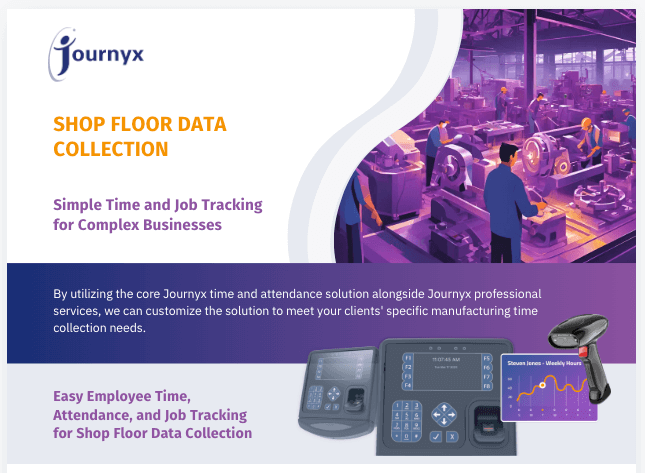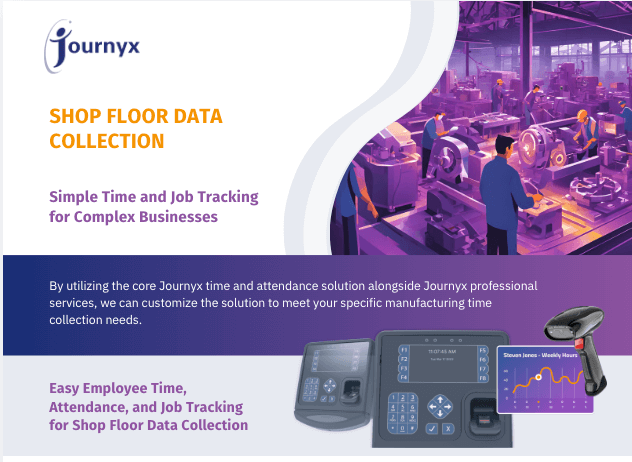How to Select the Best Time Clock for Your Business
The Ultimate Employee Time Clock System Buying Guide
Selecting and buying a time clock involves different approaches for different companies. The selection process for a system to meet your unique business needs can be tough without a guide. Fortunately, Journyx is providing this complete time clock buying guide for free.
This guide will discuss purchase criteria for all varieties of time clocks.
Time Clock Options
Before examining the purchase criteria for each time clock type, it is important to understand the distinct types of time clocks and timekeeping methods that are most used and available today.
Analog Paper-Based Timekeeping
Paper-based timekeeping systems have existed for over a century. With a paper-based timesheet system, employee labor is typically recorded by a simple mechanical timekeeping device that imprints a time stamp onto a paper timesheet, or punches holes in a paper timecard.
Paper Punch-Cards
Punch card clocks were once the most common type of time clock. With these systems, an employee placed a paper timecard into a slot in a machine that punched a tab out of the card, leaving a hole. The location of this hole would be determined by the clock’s time and would correspond to the time employees clock in or out of work.
While these machines were more resistant to tampering than the simple ink timestamps because of their use of proprietary punch cards, and the inability to “un-punch” a hole made in a card, it was still possible for employees to manipulate records and steal hours from their employers with techniques like buddy-punching.
These machines were a crucial step in developing more specialized hardware, but had significant weaknesses in their design, and would not be a practical option for workforce timekeeping today. Paper timekeeping is seen as a liability when more accurate digital solutions are available today.
Time theft and inaccurate timekeeping are common ways for a business to lose profitability, overpay or underpay employees, and expose themselves to legal risks. So, while punch-cards are certainly the most basic way to track employee time, this solution can often cost more and incur more hassle and liability than other solutions that were designed for accurate employee time and attendance.
Digital Time Clocks
Modern timekeeping systems are digital, offering instant record collection, and automatic employee time calculation. With a digital timekeeping solution, you can get a much clearer picture of how your employees are spending their time.
Digital time clocks also offer much better defenses against user error, record editing, and time theft. These tools ensure that the data you collect for timekeeping in your business is both accurate and authentic with processes like data validation, record auditing, and biometric identification
The best timekeeping systems offer integrations with payroll, accounting, and human resource services to perform advanced functions such as project time tracking, cost forecasting, benefit and PTO management, and employee payroll automation. These automated integrations save your business money and time by speeding up essential processes.
Networked Time Clocks
Networked time clocks use networked communications to synchronize data between time and attendance software and one or more time clocks.
Networked time clocks typically offer several more advanced options for clocking, including:
- PIN Entry
- Magnetic Stripe Badges
- Barcode Badges
- Proximity Badges
- Hand Shape Biometrics
- Fingerprint Biometrics
- Facial Recognition Biometrics
- Iris Biometrics
One of the goals inherent to networked time and attendance systems is to inhibit buddy punching – one employee clocking another employee in or out to receive undeserved pay – and to provide improved clarity and visibility of employees’ comings and goings. Instead of using paper timecards, which any employee could easily punch for another employee, most networked time clock deployments require input from the employee that is unique to that employee for verification, such as a PIN, a badge, or a scan of physical characteristics.
Networked time clocks are ideal for managing larger workforces, implementing advanced time and attendance rules, adding benefit accruals to the employee timekeeping process, and achieving other advanced time and attendance functionality that automates processes and eliminates payroll errors.
Biometric Time Clocks
Invariably, biometric time clocks require unique, personally identifying input from the employee that prevents buddy punching outright. By requiring biometric data such as a finger or face scan, for instance, biometric time clocks help you achieve the best return on investment for any time and attendance system.
Implementation simplification and a significant drop in cost have made biometric time clocks ideal for any sized company looking to eliminate buddy punching and achieve highly accurate timekeeping.
Web-Based Time Clocks
A web-based time clock is a time clock nonetheless. These online software systems still implement the best timekeeping practices, hold employees accountable for their time, and ensure accurate recordkeeping for your organization.
Many time and attendance software developers offer web-based employee clocking to eliminate the need for physical time clock hardware altogether.
Depending on the application and company need, sometimes a kiosk is used at a central location or entryway to serve as a surrogate time clock. At other times, when appropriate, employees are permitted to clock in and out directly from their computers.
Mobile Timekeeping Apps
Another solution that is growing in popularity is mobile timekeeping, which relies on a mobile app to allow employees to track their time from anywhere. These implementations are perfect for employees that work at multiple locations or may have to track time and tasks during on-site work.
With mobile timekeeping, geofencing rules can be used to outline areas where employees are permitted to clock in and out. This prevents employees from logging their time away from the worksite, while still providing the ease of use and flexibility offered by using a mobile timekeeping app.
Selecting the Best Time Clock for Your Organization
Since every company has unique requirements, the first step in any selection process is to form an interdepartmental committee to discuss limitations of the current system, goals for the new system, concerns, and other purchase considerations.
With a thorough understanding of common time clocks and integration options, the next step is to examine the features, planning considerations, and other purchase criteria to select the best time clock to meet the needs of your company.
Deployment Type
The most fundamental consideration is whether to implement a standalone time clock using paper timecards, a networked time clock integrated with time and attendance software, or a web-based or mobile app solution.
It is important to note that some time and attendance software providers, such as Journyx, can integrate solutions incorporating both networked time clocks and time clock-free solutions to accommodate any business needs.
When planning regarding deployment type, there are several important questions to ask:
How many employees will my business track in this system?
The more employees, the more you will want to implement an automated solution with networked time clocks. Implementation, employee enrollment, maintenance, and many other routine operations become exponentially more difficult when more employees need to be tracked manually.
Does my business have a buddy punching problem?
If so, consider networked biometric time clocks complete with time and attendance software. These thoroughly eliminate the possibility for buddy punching and employee timekeeping falsification.
Does my business want to integrate access control with our time and attendance system?
If so, networked time clocks are an ideal solution that integrates well with access control devices.
Many time and attendance software developers can implement a software time and attendance solution that also controls doors using door-mounted proximity hardware. This makes it possible to integrate access control with clock-free solutions as well as with networked time clocks.
Does my business need to track mobile employees?
If so, consider time and attendance software providers, like Journyx, that offer a fully integrated mobile time tracking app.
Clocking Methods
As previously covered, the most common clocking methods include:
- Paper Timecards
- PIN Entry
- Magnetic Stripe
- Barcode Scan
- Proximity RFID Badge
- Fingerprint and Hand Shape Biometric
- Facial Recognition and Iris Biometric
- Web-Based Time Clocking
- Mobile Apps
There is no singular technology that is the best for every circumstance. You should find the right balance of features that provides the best match for your needs.
Time Clock Reliability Comparisons
With any clocking technology, the system’s “failure rate” should be considered. This refers to the amount of error that exists in the system: misreads, false positives, and other factors that make one system more or less reliable than another.
Here, you can see some significant pros and cons for each type of clocking system:
- Paper Timecards: Paper timecards can be easily misread, are easily abused, and are prone to data entry errors.
- PIN Entry: PIN Entry time clocks are technologically sound, and usually simple to operate, but have potential for abuse such as allowing buddy-punching.
- Magnetic Stripe: Magnetic stripes wear down over time, though magnetic stripe readers offer exceptional reliability and low failure rates.
- Barcode Scan: Barcode readers offer exceptional reliability and low failure rates, but the barcode will eventually fade and can be easily marred or damaged.
- Proximity RFID Badge: Proximity badges are long-lasting and resist employee tampering, and RFID readers offer exceptional reliability and low failure rates.
- Fingerprint and Hand Shape Biometric: Proven technology that is exceptionally reliable and offers better security than any other method.
- Facial Recognition and Iris Biometric: Facial and iris recognition time clocks are reliable and offer the same security as fingerprint and hand shape biometric devices.
- Web-Based Time Clocking: Web-based time clocks are extremely reliable, but a marginal potential for abuse still exists.
- Mobile Apps: Reliability with mobile apps varies between providers, and some are more feature-complete than others.
Regardless of your environment, there is a time clock that suits your needs or an alternative clocking method that can meet your company’s demands.
Your time and attendance solution provider should be able to recommend time clock options that support the clocking technology you prefer. If a given clocking technology is truly unsuited for your environment, your solution provider should steer you in the right direction.
Integrations
When considering a time and attendance system purchase be sure to identify specific business systems — especially payroll and enterprise resource planning software — that can be integrated with the time tracking solution you choose.
Feature-rich integrations with payroll, resource allocation, and accounting software can vastly improve the potential impact of your newly upgraded timekeeping solution. Get demos of those integrations, research what clients are saying on review sites, and speak with reference customers who have had experience in similar environments with your short-list of vendors.
Purchasing Options
When it comes to purchasing a time clock, there are three primary options to consider: purchasing hardware outright, leasing hardware, and subscribing to a Clocks-as-a-Service implementation.
Purchasing a time clock outright is the most straight-forward solution. You pay one higher upfront cost, and the hardware is yours to maintain and repair from that point forward. For some devices, a limited warranty may be included, or an extended warranty may be available for purchase at the time of sale. Without these warranties, the costs of diagnosing and repairing a device that has developed a fault or been damaged can quickly pile up.
Leasing time clock hardware is another option that has a lower initial cost than purchasing outright. With this solution, you pay a lower initial cost and make a regular monthly payment over the lifetime of the device. This makes the cost of the hardware very predictable. The expense of leasing also typically includes a warranty that covers the first few years of the time clock’s use, which saves on repair costs if a fault occurs.
Subscribing to a Clocks-as-a-Service (ClaaS) model is another option for purchasing a time clock. In this case, you pay a fixed monthly cost similar to the cost of leasing the device that also includes a lifetime warranty, first-class support, and even repair/replacement timeframe guarantees for your time clock. Maintaining a large fleet of time clocks without a service-oriented program can result in a management nightmare of managing warranties, support, and device replacements. And, in many cases, Clocks-as-a-Service can provide for a lower cost of ownership over the life of the time clocks.
The Bottom Line
There are many factors to consider when selecting a time clock solution for your company. In order to be confident in your selection, you must thoroughly consider timeclock varieties, deployment types, clocking methods, device reliability, integrations, and even purchase methods.
Every company has unique needs for their timekeeping solution and balancing these needs can be difficult without professional guidance. Contact Journyx today for a consultation and ensure that you have the best time clock solution possible to meet your company’s unique needs.
Let’s Get Started. Book a Demo Today.
Journyx helps you track time for projects, payroll, and more. Learn how Journyx can help you use time to your advantage in your business.



